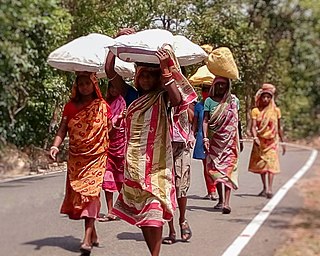
Manbhum District was one of the districts of the East India during the British Raj. After India's independence, the district became a part of Bihar State. Upon the reorganization of the Indian states in the mid-1950s, the Manbhum district was partitioned based on language. The Bengal-speaking areas were included in West Bengal, while the rest were kept with Bihar.

Surajit Chandra Sinha was an Indian anthropologist.

The Sonbarsa Raj was a medieval chieftaincy and later a zamindari (estate) during British Raj in modern-day Bihar, in erstwhile Bhagalpur district. It was controlled by the Gandhavariya Rajputs.

Bhumij is a Munda ethnic group of India. They primarily live in the Indian states of West Bengal, Odisha, Assam and Jharkhand, mostly in the old Singhbhum district. Also in states like Bihar and Assam. There is also a sizeable population found in Bangladesh. Bhumijas speak the Bhumij language, an Austroasiatic language, and use Ol Onal script for writing.
Chuar rebellion or Chuar revolt, also known as Jungle Mahal movement was a series of peasant movements between 1771 and 1809 by the tribal inhabitants of the countryside surrounding the Jungle Mahals settlements of Dhalbhum, Midnapore, Bankura and Manbhum against the rule of the East India Company(EIC).
Below is given a chronological record of tribal and peasant revolts in India before independence from British rule in the 1947. The list covers those tribal uprisings that occurred during the period of British rule in India.

The Kudmi Mahato are a tribal community in the states of Jharkhand, West Bengal and Odisha of India. They are primarily agriculturalist.
The Lok Sewak Sangh, or Manbhum Lok Sewak Sangh, was a political party in Purulia District, West Bengal, India. LSS was founded in 1948. The party was the main political force in Purulia District from the independence of India until the fall of the second United Front cabinet.

Jhargram Raj was a zamindari which occupied a position in Bengal region of British India. The zamindari came into being during the later part of the 16th century when Man Singh of Amer was the Dewan/Subahdar of Bengal (1594–1606). Their territory was centered around present-day Jhargram district. Jhargram was never an independent territory since the chiefs of the family held it basically as the zamindars of the British Raj in India after Lord Cornwallis's Permanent Settlement of 1793. Although its owners were both rich and powerful, with the chiefs of the family holding the title of Raja, the Jhargram estate was not defined as a Princely State with freedom to decide its future course of action at the time of Indian independence in 1947. Later, the Vice-Roy of India agreed to recognize Jhargram as "Princely State" after the Second World War, but the proposal taken back as the British had decided to give independence to India.
Dumraon Raj was a medieval chieftaincy and later a zamindari estate in erstwhile Shahabad district of Bihar. The total area under this zamindari was 4,85,000 acres which is equivalent to 1963 Square Kilometer.
Kuruktopa is a village in the Puncha CD block in the Manbazar subdivision of the Purulia district in the state of West Bengal, India.

Bagal is a cattle herding caste of East India. Bagal people are living in the state of West Bengal, Jharkhand and Odisha. They use Kudmali / Manbhumi dialect of Bengali as mother tongue and use Bengali, Hindi and Odia language to communicate with the society.
The Bhumij Rebellion or Bhumij Revolt, also known as Ganga Narain's Hungama was a revolt during 1832–1833 by Bhumij tribals based in the Dhalbhum and Jungle Mahal areas of the Midnapore district of the erstwhile Bengal state. It was led by Ganga Narayan Singh.
Rani Shiromani was the queen of Karnagarh, during the British rule in India. She was a valiant leader of peasants who rebelled against the British East India Company. she played a major role in the Chuar rebellion in Midnapore. She created the first revolt against the British through the farmers in Midnapore. She was against the British East India Company and refused to pay taxes. Thus, she was called as the Rani Laxmi Bai of Midnapore.
Durjan Singh was a great leader of Chuar rebellion of Bengal. Singh was a zamindar of Raipur in Bengal. He led the Chuar rebellion in 1798–99 in Midnapore district against the British East India Company.

Ganga Narayan Singh was an Indian revolutionary from Jungle Mahals, known as the leader of Bhumij rebellion. He led a revolt against the East India Company in 1832-33. The British called it "Ganga Narain's Hungama", while some historians have called it the Chuar rebellion.

Patkum estate was one of the zamindari estates of India during the period of the British Raj. It is believed that the estate was found by scion of the King Vikramaditya of Solar dynasty. During British raj it was part of Bengal presidency, composing todays Chandil, Kukru, Nimdih, Ichagarh and Kandra. Ichagarh was the capital of the state.
Damodar Shekhar was the first king of the Panchkot Raj family. Panchkot Raj family belonged to the Rajput.
Buli Mahato was a revolutionary leader of the Bhumij Rebellion and Kol Rebellion. He was a zamindar of the Kudmi community of Karadih village in Sonahatu Thana, Jharkhand.
The Dhal dynasty was a dynasty that ruled the parts of the present-day Indian states of Jharkhand and West Bengal, known as the Rajas of Dhalbhum or Ghatshila. Their capital was located at Ghatshila in East Singhbhum district. Their rule lasted till the British era.









